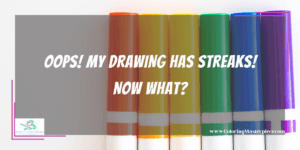Streaking is a common problem for adult coloring book artists. Streaks happen when several layers of color overlap, giving the appearance of a lumpy, non-consistent design. Some areas within the same color are lighter, and some areas are darker. Streaking is most common when using markers as your coloring instrument. If you want to take your coloring to the next level, then this guide is for you!
Set yourself up for success with a book printed on the best paper

By taking a few conscious steps before you ever sit down at the table to color, you can minimize the streaks’ appearance on your page.
Selecting a coloring book at the store with the best quality paper is one way that you can help yourself create consistent color. Think of your paper as being akin to your kitchen towel. You’ve spilled some water on the table, and you need to clean it up. Using a cotton towel with thick, loose weaves of fiber will soak up the water a lot faster and easier than, for example, a cloth napkin, which has a thinner and tighter weave of fibers. The napkin will still clean up the mess, but you might need to let the napkin sit on the water spill for a few minutes while the moisture gets through and into the fibers.
Paper works the same way. However, your goal in coloring is to keep the moisture from the ink sit pooled on the paper for a short period—you do NOT want the ink to soak into the paper quickly. When the ink dries quickly, that’s what causes your pen strokes to overlap and appear darker. If the ink pools on the page for a short time, the water/oil molecules join one another, creating a more even look.
Unfortunately, coloring books do not identify on the title page the kind of paper they are printed on, so you need to use your fingers to touch the page. Compare several coloring books at once, and if you are going to color with markers, try to find one:
With thick pages. Heavy cardstock takes longer for the ink to soak in. Also, heavy paper prevents bleeding onto the next page. Stay away from thin pages, like office copy paper.
With a tight weave. If you are graced with good eyesight, look very closely at the paper, even holding it at an angle. If you can see gaps in the paper fibers, you will want to put that coloring book away. As an extreme example, paper made from homemade or recycled fibers is notorious for having very loose weaves, making that type of paper ideal for certain types of artists but not for what you want to achieve.
Look for paper with only the slightest sheen to it. Matte paper often works best for coloring with markers. It has a slight coating, which will slow down the ink absorption into the page. An uncoated page will absorb too quickly, and a glossy page will prevent the ink from absorbing at all.
Interested in staying eco-friendly with your hobby? Check out Can Colored Paper Be Recycled?
Choose a maker that doesn’t dry too quickly
There are typically two kinds of markers readily available for coloring: alcohol-based and water-based markers. Neither marker is better or worse than the other; your marker choice might be based on whether you prefer to add a blending stage or if you are a quicker or slower worker.
Alcohol-based markers will dry faster than water-based markers, so these are ideal for those that work more quickly. Copic, Uni-Posca, and Ohuhu markers are well-regarded in the artist community for their quality and how easily they do.
Water-based markers dry a little slower but may be prone to pooling ink in inconsistent ways depending on how much ink is on the page. You’ll want a consistent touch when using water-based markers. You can do a lot of enjoyable and exciting designs using blending with water-based markers. Arteza Windsor and Newton are two brands that you may want to try.
Whether you choose alcohol-based or water-based markers, try experimenting on a blank page of the coloring book. I often use the title page for experiments. Use your experimental page to see how quickly the ink dries, how fast you need to move your hand, how well the ink blends, and how the ink looks when it overlaps.
Work on your technique to minimize streaking
No marker will be streak-free, so if you want to make your coloring as consistent as possible, you need to work on your technique.
Streaking does not usually appear when you are coloring small spaces. Streaking is more apparent when you’re working in large areas of open white space. It is these areas that we are most concerned with for this article.
One option is to color in small circles instead of side-to-side or up-and-down. When you are using a circular motion, keep your circles reasonably small, and overlap the edges consistently so that all the areas receive even 2 or 3 coats of ink. Remember that the more that you overlap, the darker your color will be. You may want to choose a two-shade lighter color than what you are hoping to achieve if you are overlapping several times. Play with this on your practice page. Using a circular motion is an easy technique for beginners.
If you are looking for more of a challenge, then try a flicking pattern. When you are flicking your pen, you start in the area where you want to be darker—usually outside the shape. You flick your marker towards the extent that you want to be lighter—in this case, the inside of the shape. Continue this motion until you have the shape surrounded. Then switch your pen to a slightly lighter shade, and use it to blend into the darker area, overlapping as necessary. Starting your motion at the outside of the shape helps ensure that you don’t color outside the lines. Flicking involves reasonable control over your marker tip’s strength and direction, and it also requires more advanced blending and shading. The final look when using the flicking technique is often very professional, with a lovely glimpse of dark and lighter areas that give the design depth and softness. This is a beneficial tutorial about how to use the flicking technique.
Oops! My drawing has streaks! Now what?

It’s tough to color in such a way that streaking doesn’t happen at all. When it happens, how you “fix” the streaking depends on the kind of marker you are using. Here are some tips you can try:
-
- Try dipping a Q-tip into a little rubbing alcohol and gently smudge the streak to lighten it a little. This technique is best used on alcohol-based ink.
- Use a marker in a slightly lighter shade, and color over the areas with more golden ink. By drawing a second layer of ink, you’ll darken the lighter room, hopefully matching the darker “streak” area.
- Try dipping a thin brush or a Q-tip in a little water if you are working with a water-based marker. Using only a little pressure, fan the water outwards, starting from the darkest place and flicking your brush or Q-tip outward towards the lighter area. Start with only the tiniest bit of water you can apply, and gradually add more water if needed.
Remember that it’s impossible to create a “perfect,” error-free page. Streaking is a part of the art, and it’s best to embrace the streaking. See your mistakes as an opportunity to try a new technique, like blending. You can also use the error as a chance to create a new color mix that you hadn’t used before. Otherwise, the critical takeaway from this article is to remember that overlapping ink will create dark patches. To fix a streak, you can adjust your light area to match the darker one by overlapping the ink with a slightly darker shade. You can lighten the dark patch using rubbing alcohol or water to lift some of the ink off the page.
Want to learn more about mindful coloring? Click here to download my free adult coloring eBook and sign up for my email newsletter!
Disclaimer: The information provided by ColoringMasterpiece.com (“The Site”) is for general informational purposes only. All information on the Site is provided in good faith, however, we make no representation or warranty of any kind, express or implied, regarding the accuracy, adequacy, validity, reliability, availability, or completeness of any information on the Site. Under no circumstance shall we have any liability to you for any loss or damage of any kind incurred as a result of the use of the Site or Reliance on any information provided on the Site. Your use of the Site and your reliance on any information on the Site is solely at your own risk. This blog post is for educational purposes only and does not constitute legal advice. Please consult a legal expert to address your specific needs.
Terms and Conditions: https://coloringmasterpiece.com/terms-and-conditions/
